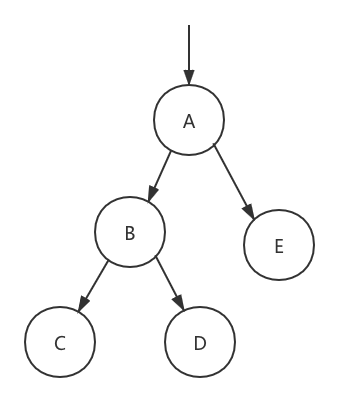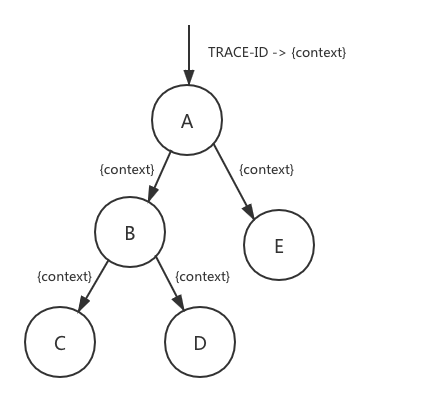为什么项目内需要链路追踪?
当一个请求中,请求了多个服务单元,如果请求出现了错误或异常,很难去定位是哪个服务出了问题,这时就需要链路追踪。

这个图画的比较简单,从图中可以清晰的看出他们之间的调用关系,通过一个例子说明下链路的重要性,比如对方调我们一个接口,反馈在某个时间段这接口太慢了,在排查代码发现逻辑比较复杂,不光调用了多个三方接口、操作了数据库,还操作了缓存,怎么快速定位是哪块执行时间很长?
不卖关子,先说下本篇文章最终实现了什么,如果感兴趣再继续往下看。
实现了通过记录如下参数,来进行问题定位,关于每个参数的结构在下面都有介绍。
// Trace 记录的参数
type Trace struct {
mux sync.Mutex
Identifier string `json:"trace_id"` // 链路 ID
Request *Request `json:"request"` // 请求信息
Response *Response `json:"response"` // 响应信息
ThirdPartyRequests []*Dialog `json:"third_party_requests"` // 调用第三方接口的信息
Debugs []*Debug `json:"debugs"` // 调试信息
SQLs []*SQL `json:"sqls"` // 执行的 SQL 信息
Redis []*Redis `json:"redis"` // 执行的 Redis 信息
Success bool `json:"success"` // 请求结果 true or false
CostSeconds float64 `json:"cost_seconds"` // 执行时长(单位秒)
}
参数结构
链路 ID
String 例如:4b4f81f015a4f2a01b00。如果请求 Header 中存在 TRACE-ID,就使用它,反之,重新创建一个。将 TRACE_ID 放到接口返回值中,这样就可以通过这个标示查到这一串的信息。
请求信息
Object,结构如下:
type Request struct {
TTL string `json:"ttl"` // 请求超时时间
Method string `json:"method"` // 请求方式
DecodedURL string `json:"decoded_url"` // 请求地址
Header interface{} `json:"header"` // 请求 Header 信息
Body interface{} `json:"body"` // 请求 Body 信息
}
响应信息
Object,结构如下:
type Response struct {
Header interface{} `json:"header"` // Header 信息
Body interface{} `json:"body"` // Body 信息
BusinessCode int `json:"business_code,omitempty"` // 业务码
BusinessCodeMsg string `json:"business_code_msg,omitempty"` // 提示信息
HttpCode int `json:"http_code"` // HTTP 状态码
HttpCodeMsg string `json:"http_code_msg"` // HTTP 状态码信息
CostSeconds float64 `json:"cost_seconds"` // 执行时间(单位秒)
}
调用三方接口信息
Object,结构如下:
type Dialog struct {
mux sync.Mutex
Request *Request `json:"request"` // 请求信息
Responses []*Response `json:"responses"` // 返回信息
Success bool `json:"success"` // 是否成功,true 或 false
CostSeconds float64 `json:"cost_seconds"` // 执行时长(单位秒)
}
这里面的 Request 和 Response 结构与上面保持一致。
细节来了,为什么 Responses 结构是 []*Response ?
是因为 HTTP 可以进行重试请求,比如当请求对方接口的时候,HTTP 状态码为 503 http.StatusServiceUnavailable,这时需要重试,我们也需要把重试的响应信息记录下来。
调试信息
Object 结构如下:
type Debug struct {
Key string `json:"key"` // 标示
Value interface{} `json:"value"` // 值
CostSeconds float64 `json:"cost_seconds"` // 执行时间(单位秒)
}
SQL 信息
Object,结构如下:
type SQL struct {
Timestamp string `json:"timestamp"` // 时间,格式:2006-01-02 15:04:05
Stack string `json:"stack"` // 文件地址和行号
SQL string `json:"sql"` // SQL 语句
Rows int64 `json:"rows_affected"` // 影响行数
CostSeconds float64 `json:"cost_seconds"` // 执行时长(单位秒)
}
Redis 信息
Object,结构如下:
type Redis struct {
Timestamp string `json:"timestamp"` // 时间,格式:2006-01-02 15:04:05
Handle string `json:"handle"` // 操作,SET/GET 等
Key string `json:"key"` // Key
Value string `json:"value,omitempty"` // Value
TTL float64 `json:"ttl,omitempty"` // 超时时长(单位分)
CostSeconds float64 `json:"cost_seconds"` // 执行时间(单位秒)
}
请求结果
Bool,这个和统一定义返回值有点关系,看下代码:
// 错误返回
c.AbortWithError(code.ErrParamBind.WithErr(err))
// 正确返回
c.Payload(code.OK.WithData(data))
当错误返回时 且 ctx.Writer.Status() != http.StatusOK 时,为 false,反之为 true。
执行时长
Float64,例如:0.041746869,记录的是从请求开始到请求结束所花费的时间。
如何收集参数?
这时有老铁会说了:“规划的稍微还行,使用的时候会不会很麻烦?”
“No,No,使用起来一丢丢都不麻烦”,接着往下看。
无需关心的参数
链路 ID、请求信息、响应信息、请求结果、执行时长,这 5 个参数,开发者无需关心,这些都在中间件封装好了。
调用第三方接口的信息
只需多传递一个参数即可。
在这里厚脸皮自荐下 httpclient 包 。
-
支持设置失败时重试,可以自定义重试次数、重试前延迟等待时间、重试的满足条件; -
支持设置失败时告警,可以自定义告警渠道(邮件/微信)、告警的满足条件; -
支持设置调用链路;
调用示例代码:
// httpclient 是项目中封装的包
api := "http://127.0.0.1:9999/demo/post"
params := url.Values{}
params.Set("name", name)
body, err := httpclient.PostForm(api, params,
httpclient.WithTrace(ctx.Trace()), // 传递上下文
)
调试信息
只需多传递一个参数即可。
调用示例代码:
// p 是项目中封装的包
p.Println("key", "value",
p.WithTrace(ctx.Trace()), // 传递上下文
)
SQL 信息
稍微复杂一丢丢,需要多传递一个参数,然后再写一个 GORM 插件。
使用的 GORM V2 自带的 Callbacks 和 Context 知识点,细节不多说,可以看下这篇文章:基于 GORM 获取当前请求所执行的 SQL 信息。
调用示例代码:
// 原来查询这样写
err := u.db.GetDbR().
First(data, id).
Where("is_deleted = ?", -1).
Error
// 现在只需这样写
err := u.db.GetDbR().
WithContext(ctx.RequestContext()).
First(data, id).
Where("is_deleted = ?", -1).
Error
// .WithContext 是 GORM V2 自带的。
// 插件的代码就不贴了,去上面的文章查看即可。
Redis 信息
只需多传递一个参数即可。
调用示例代码:
// cache 是基于 go-redis 封装的包
d.cache.Get("name",
cache.WithTrace(c.Trace()),
)
核心原理是啥?
在这没关子可卖,看到这相信老铁们都知道了,就两个:一个是 拦截器,另一个是 Context。

如何记录参数?
将以上数据转为 JSON 结构记录到日志中。
JSON 示例
{
"level":"info",
"time":"2021-01-30 22:32:48",
"caller":"core/core.go:444",
"msg":"core-interceptor",
"domain":"go-gin-api[fat]",
"method":"GET",
"path":"/demo/trace",
"http_code":200,
"business_code":1,
"success":true,
"cost_seconds":0.054025302,
"trace_id":"2cdb2f96934f573af391",
"trace_info":{
"trace_id":"2cdb2f96934f573af391",
"request":{
"ttl":"un-limit",
"method":"GET",
"decoded_url":"/demo/trace",
"header":{
"Accept":[
"application/json"
],
"Accept-Encoding":[
"gzip, deflate, br"
],
"Accept-Language":[
"zh-CN,zh;q=0.9,en;q=0.8"
],
"Authorization":[
"eyJhbGciOiJIUzI1NiIsInR5cCI6IkpXVCJ9.eyJVc2VySUQiOjEsIlVzZXJOYW1lIjoieGlubGlhbmdub3RlIiwiZXhwIjoxNjEyMTAzNTQwLCJpYXQiOjE2MTIwMTcxNDAsIm5iZiI6MTYxMjAxNzE0MH0.2yHDdP7cNT5uL5xA0-j_NgTK4GrW-HGn0KUxcbZfpKg"
],
"Connection":[
"keep-alive"
],
"Referer":[
"http://127.0.0.1:9999/swagger/index.html"
],
"Sec-Fetch-Dest":[
"empty"
],
"Sec-Fetch-Mode":[
"cors"
],
"Sec-Fetch-Site":[
"same-origin"
],
"User-Agent":[
"Mozilla/5.0 (Macintosh; Intel Mac OS X 10_15_6) AppleWebKit/537.36 (KHTML, like Gecko) Chrome/88.0.4324.96 Safari/537.36"
]
},
"body":""
},
"response":{
"header":{
"Content-Type":[
"application/json; charset=utf-8"
],
"Trace-Id":[
"2cdb2f96934f573af391"
],
"Vary":[
"Origin"
]
},
"body":{
"code":1,
"msg":"OK",
"data":[
{
"name":"Tom",
"job":"Student"
},
{
"name":"Jack",
"job":"Teacher"
}
],
"id":"2cdb2f96934f573af391"
},
"business_code":1,
"business_code_msg":"OK",
"http_code":200,
"http_code_msg":"OK",
"cost_seconds":0.054024874
},
"third_party_requests":[
{
"request":{
"ttl":"5s",
"method":"GET",
"decoded_url":"http://127.0.0.1:9999/demo/get/Tom",
"header":{
"Authorization":[
"eyJhbGciOiJIUzI1NiIsInR5cCI6IkpXVCJ9.eyJVc2VySUQiOjEsIlVzZXJOYW1lIjoieGlubGlhbmdub3RlIiwiZXhwIjoxNjEyMTAzNTQwLCJpYXQiOjE2MTIwMTcxNDAsIm5iZiI6MTYxMjAxNzE0MH0.2yHDdP7cNT5uL5xA0-j_NgTK4GrW-HGn0KUxcbZfpKg"
],
"Content-Type":[
"application/x-www-form-urlencoded; charset=utf-8"
],
"TRACE-ID":[
"2cdb2f96934f573af391"
]
},
"body":null
},
"responses":[
{
"header":{
"Content-Length":[
"87"
],
"Content-Type":[
"application/json; charset=utf-8"
],
"Date":[
"Sat, 30 Jan 2021 14:32:48 GMT"
],
"Trace-Id":[
"2cdb2f96934f573af391"
],
"Vary":[
"Origin"
]
},
"body":"{"code":1,"msg":"OK","data":{"name":"Tom","job":"Student"},"id":"2cdb2f96934f573af391"}",
"http_code":200,
"http_code_msg":"200 OK",
"cost_seconds":0.000555089
}
],
"success":true,
"cost_seconds":0.000580202
},
{
"request":{
"ttl":"5s",
"method":"POST",
"decoded_url":"http://127.0.0.1:9999/demo/post",
"header":{
"Authorization":[
"eyJhbGciOiJIUzI1NiIsInR5cCI6IkpXVCJ9.eyJVc2VySUQiOjEsIlVzZXJOYW1lIjoieGlubGlhbmdub3RlIiwiZXhwIjoxNjEyMTAzNTQwLCJpYXQiOjE2MTIwMTcxNDAsIm5iZiI6MTYxMjAxNzE0MH0.2yHDdP7cNT5uL5xA0-j_NgTK4GrW-HGn0KUxcbZfpKg"
],
"Content-Type":[
"application/x-www-form-urlencoded; charset=utf-8"
],
"TRACE-ID":[
"2cdb2f96934f573af391"
]
},
"body":"name=Jack"
},
"responses":[
{
"header":{
"Content-Length":[
"88"
],
"Content-Type":[
"application/json; charset=utf-8"
],
"Date":[
"Sat, 30 Jan 2021 14:32:48 GMT"
],
"Trace-Id":[
"2cdb2f96934f573af391"
],
"Vary":[
"Origin"
]
},
"body":"{"code":1,"msg":"OK","data":{"name":"Jack","job":"Teacher"},"id":"2cdb2f96934f573af391"}",
"http_code":200,
"http_code_msg":"200 OK",
"cost_seconds":0.000450153
}
],
"success":true,
"cost_seconds":0.000468387
}
],
"debugs":[
{
"key":"res1.Data.Name",
"value":"Tom",
"cost_seconds":0.000005193
},
{
"key":"res2.Data.Name",
"value":"Jack",
"cost_seconds":0.000003907
},
{
"key":"redis-name",
"value":"tom",
"cost_seconds":0.000009816
}
],
"sqls":[
{
"timestamp":"2021-01-30 22:32:48",
"stack":"/Users/xinliang/github/go-gin-api/internal/api/repository/db_repo/user_demo_repo/user_demo.go:76",
"sql":"SELECT `id`,`user_name`,`nick_name`,`mobile` FROM `user_demo` WHERE user_name = 'test_user' and is_deleted = -1 ORDER BY `user_demo`.`id` LIMIT 1",
"rows_affected":1,
"cost_seconds":0.031969072
}
],
"redis":[
{
"timestamp":"2021-01-30 22:32:48",
"handle":"set",
"key":"name",
"value":"tom",
"ttl":10,
"cost_seconds":0.009982091
},
{
"timestamp":"2021-01-30 22:32:48",
"handle":"get",
"key":"name",
"cost_seconds":0.010681579
}
],
"success":true,
"cost_seconds":0.054025302
}
}
zap 日志组件
有对日志收集感兴趣的老铁们可以往下看,trace_info 只是日志的一个参数,具体日志参数包括:
| 参数 | 数据类型 | 说明 |
|---|---|---|
| level | String | 日志级别,例如:info,warn,error,debug |
| time | String | 时间,例如:2021-01-30 16:05:44 |
| caller | String | 调用位置,文件+行号,例如:core/core.go:443 |
| msg | String | 日志信息,例如:xx 错误 |
| domain | String | 域名或服务名,例如:go-gin-api[fat] |
| method | String | 请求方式,例如:POST |
| path | String | 请求路径,例如:/user/create |
| http_code | Int | HTTP 状态码,例如:200 |
| business_code | Int | 业务状态码,例如:10101 |
| success | Bool | 状态,true or false |
| cost_seconds | Float64 | 花费时间,单位:秒,例如:0.01 |
| trace_id | String | 链路ID,例如:ec3c868c8dcccfe515ab |
| trace_info | Object | 链路信息,结构化数据。 |
| error | String | 错误信息,当出现错误时才有这字段。 |
| errorVerbose | String | 详细的错误堆栈信息,当出现错误时才有这字段。 |
日志记录可以使用 zap,logrus ,这次我使用的 zap,简单封装一下即可,比如:
-
支持设置日志级别; -
支持设置日志输出到控制台; -
支持设置日志输出到文件; -
支持设置日志输出到文件(可自动分割);
总结
这个功能比较常用,使用起来也很爽,比如调用方发现接口出问题时,只需要提供 TRACE-ID 即可,我们就可以查到关于它整个链路的所有信息。
以上代码都在 go-gin-api 项目中,地址:https://github.com/xinliangnote/go-gin-api
推荐阅读

文章评论